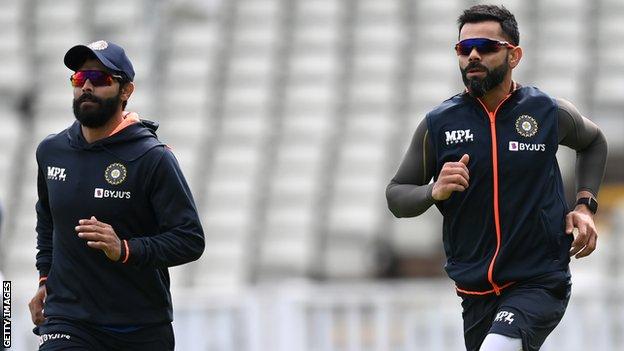| Venue: Edgbaston Dates: 1-5 July Time: 10:30 BST |
| Coverage: Test Match Special commentary, text commentary and in-play highlights on BBC Sport website and app. Daily highlights at 19:00 on BBC Four |
Last September, India were three hours away from starting the fifth Test in Manchester against an England batting line-up that had just subsided to a fifth-day defeat for the second time in three games, with only one player in form, and having won one and lost six of their previous nine Tests, midway through what became their worst run of form for almost three decades.
They pulled out of the game, and will now attempt to secure their fourth series victory in England against a fundamentally different opposition.
Only five players remain in England’s current squad who played in the fourth-Test defeat at The Oval (including Craig Overton, who is unlikely to be selected at Edgbaston on Friday), and they will face a new coach, captain and cricketing philosophy.
They will find Joe Root once again touching heights of batting perfection, but little else of familiarity from last year.
England have completed one of the most remarkable Test series in their history – three wins (two more than they have managed in their previous 17 Tests), three entries into their top 13 highest successful fourth-innings run chases, and the second fastest run-rate by a team in a Test series of at least three matches (4.54, even with a relatively sedate first Test at Lord’s).
Root has become the second player, after Australia’s Undisputed Greatest Batter Of All Time Don Bradman, to average more than 90 in three separate series in England (five innings minimum), having also done so against India both last summer and in 2014.
Meanwhile, Jonny Bairstow compiled the second fastest-scoring individual series by a player who has faced at least 200 balls, his 394 runs coming at a rate of 120 per 100 balls, fractionally behind Shahid Afridi, who thwacked 330 off 272 for Pakistan against India in 2005-06.
He contributed the bulk of two of the fastest recorded partnerships of 100 or more (with Stokes at Trent Bridge, and with Root at Headingley), and shared with debutant Jamie Overton the highest partnership for the seventh wicket or lower ever made by a pair coming together with fewer than 100 runs on the board (241, beating the previous record of 190 by Pakistan’s Asif Iqbal and Intikhab Alam, who came together at 65-8 at The Oval in 1967).
Since his second innings at Trent Bridge, he has scored at a pace that would bring a score of 680-4 from an uninterrupted 90-over day of Test cricket.
It will be a vast challenge for India, themselves under new leadership, with minimal preparation and potentially without both Rohit Sharma and KL Rahul, the openers whose discipline and restraint – qualities which do, contrary to some rumours, remain both legal and often valuable in Test cricket – were fundamental to India’s successes last summer.
How to play Test cricket
If England offered India one ‘blueprint’ for how to play Test cricket, having jettisoned the various anti-blueprints with which they had experimented over the previous 18 months, Daryl Mitchell (only the fourth player to make centuries in three defeats in a single Test series) and Tom Blundell offered another, more traditional one.
Their partnerships were the equivalent, with current over rates, of batting well into the final session of the third day of a Test, posting 724-6 off 236 overs (the most runs ever added in a series by a pair of batters in the middle order).
Their stands averaged 121 off 39 overs, and provided the perfect object lesson in how to bat against England’s attack, an example which their team-mates flatly, repeatedly and often incomprehensibly ignored.
Outside of the Mitchell-Blundell resistance, New Zealand lost a wicket every 39 balls, batting with a carelessness and imprecision at odds with the qualities that had taken them to victory in the inaugural World Test Championship.
Kohli wobbles

While England were being demolished in Australia, India played in South Africa, where they lost a low-scoring series 2-1 – the home team winning the second and third Tests by comfortably chasing down fourth-innings targets in excess of 200 after tightly-fought first innings, which has become an extremely trendy way of winning Test matches.
After the final Test defeat, Virat Kohli stepped down as captain, since when he has had three moderate innings in thumping Indian Test victories against Sri Lanka, and his worst IPL season since 2009.
He remains without a century since late 2019, in which time he has played 17 Tests and averaged 28, scoring at just 42 per 100 balls.
Over his previous 55 Tests, from December 2014, he had averaged 63 with a strike-rate of 61 per 100, and converted 21 of his 34 half-centuries into three-figure scores.
The confident mastery and run-addicted persistence have disappeared from his batting, a decline perhaps caused, and almost certainly exacerbated, by the effects of years of all-format cricket and captaincy.
Great players have experienced and emerged from similar career troughs – one of England’s greatest, Wally Hammond, failed to reach 50 in 22 Test innings in a 14-Test sequence from 1933 to 1935, having averaged 73 in his 30 previous Tests (from his breakthrough 900-run Ashes triumph in Australia in 1928-29), and before going on to average 76 in his next 25 matches until the outbreak of war.
After scoring an unbeaten 194 against Pakistan in March 2005, Sachin Tendulkar’s Test career average stood at 58. From April 2004 to November 2007, excluding four games against a weak Bangladesh team, he averaged 32 against top-eight Test teams, with just one hundred in 27 matches. His next 35 Tests brought him 14 centuries and an average of 64.
Joe Root had averaged 31 in his last 21 home Tests (with only one century) before India arrived last summer. Since then, in his seven home Tests, he has 960 runs at an average of 96, and was on a seemingly unstoppable course to a sixth century in those seven games until Bairstow’s series-concluding barrage on Monday.
Kohli’s ability to emerge from his long-term statistical slumber in this strange one-off 10-months-delayed series decider could define whether last summer becomes one of the great triumphs of his now-concluded captaincy career.
Blistering Bairstow
The Bairstow who faced India last summer was, it is fair to say, not the player we are seeing in 2022.
He made several promising starts, and had largely rectified his problem of being bowled out alarmingly often, but was unable to develop his innings into anything substantial.
From 2019 to 2021, he did not reach 60 in 19 Tests. In his last nine innings of 25 or more, he had reached 40 only once.
In 2022, in seven Tests, he has made four hundreds, all of them at number five or six with fewer than 60 runs on the board (no other batter in Test history has had four such innings in a calendar year).
He came in at 36-4 in Sydney in January, with England facing another humiliation to follow their 68 all out at the MCG, and made a magnificent 113.
In the first Test in West Indies, he resurrected England from 48-4 with a controlled 140.
At Nottingham, his team were 56-3 in the fourth innings, chasing 299 to win, when he unleashed the second-fastest England Test century.
And at Headingley, England were 17-3 (soon to be 55-6) before he made the second fastest 150 by an England player.
In all, the last nine of Bairstow’s 10 Test centuries have been made with England in something between ‘some trouble’ and ‘absolute chaos’ – before this year, scores of 83-5, 84-4, 131-4, 94-5 and 22-1 had been the starting points for his hundreds since he first reached three figures having joined Ben Stokes at 223-5 in Cape Town in 2015-16.
Fourth-innings fun
The comparison between England’s three fourth-innings performances with the bat last summer and their trilogy of successful chases this summer could hardly be more extreme.
In 2021, in the first Test of the summer, they declined to chase 273 in 75 overs on a docile Lord’s pitch after Kane Williamson’s declaration, even after seeing off the first 20 overs without loss.
Against India, they achieved the rare feat of beginning a fourth innings after lunch on the final day, and being bowled to defeat.
At The Oval, after reaching 100-0 on the fifth morning, they were skittled in another 52 overs. This year, they have chased more than 275 to win in three successive matches, scoring a total of 874-13 at 4.8 runs per over.
Fretfulness and failure have been replaced with flamboyant floggery and flayful fearlessness.
Why are the balls not seaming?
The ball-tracking information shows the ball is moving considerably less off the seam throughout this summer’s matches (around 15% less deviation for pace bowlers, counting deliveries defined as good or full-length in the CricViz data) compared with the previous five English Test seasons, and also swinging a little less.
The fourth umpire ambling out with his mysterious suitcase of replacement balls has become one of the sights of the summer, along with the chuntering seamer and, in the Test Match Special commentary box, the speculation over exactly what to call the device the umpires use for defining the unshapeliness of a failing cricket ball.
As a result, seamers with the older ball, in overs 31-80, averaged 48.7 in the New Zealand series, up from 27.8 over the previous five English seasons, and even discounting England’s fourth-innings blasts, seamers with the old ball in the first three innings averaged 38.2 (up from the 2017-2021 figure of 27.4).
Quite why this year’s Dukes balls have been so abjectly inadequate remains something of a mystery, perhaps caused by a secretive cabal of international batters harnessing the power of the occult, perhaps by Darwin-loving cows speed-evoluting their skin to become less suitable for beleatherment and hence usage in cricket ball manufacture, or perhaps by something else.




















